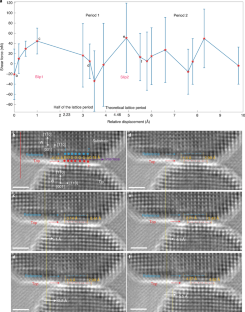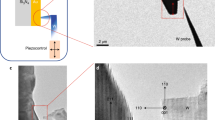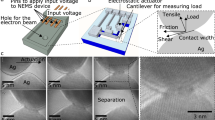Abstract
Friction and wear are detrimental to functionality and reduce the service life of products with mechanical elements. Here, we unveil the atomic-scale friction of a single tungsten asperity in real time through a high-resolution transmission electron microscopy investigation of a nanocontact in countermotion, induced through a piezo actuator. Molecular dynamics simulations provide insights into the sliding pathway of interface atoms and the dynamic strain/stress evolution at the interface. We observe a discrete stick–slip behaviour and an asynchronous process for the accumulation and dissipation of the strain energy together with the non-uniform motion of interface atoms. Our methodology allows for studying in situ atomic-friction phenomena and provides insights into friction phenomena at the atomic scale.
This is a preview of subscription content, access via your institution
Access options
Access Nature and 54 other Nature Portfolio journals
Get Nature+, our best-value online-access subscription
$29.99 / 30 days
cancel any time
Subscribe to this journal
Receive 12 print issues and online access
$259.00 per year
only $21.58 per issue
Buy this article
- Purchase on Springer Link
- Instant access to full article PDF
Prices may be subject to local taxes which are calculated during checkout





Similar content being viewed by others
Data availability
All data needed to evaluate the conclusions have been included in the paper/or the Supplementary Materials. Source data are provided with this paper. Additional data related to this paper can be requested from the corresponding authors S.X.M. (sxm2@pitt.edu) or G.W. (guw8@pitt.edu).
Change history
08 June 2022
A Correction to this paper has been published: https://doi.org/10.1038/s41565-022-01167-4
References
Achanta, S. & Celis, J.-P. in Fundamentals of Friction and Wear on the Nanoscale (eds Gnecco, E. & Meyer, E.) 631–656 (Springer, 2015).
Jacobs, T. D. B., Greiner, C., Wahl, K. J. & Carpick, R. W. Insights into tribology from in situ nanoscale experiments. MRS Bull. 44, 478–486 (2019).
Park, J. Y. & Salmeron, M. Fundamental aspects of energy dissipation in friction. Chem. Rev. 114, 677–711 (2014).
Mate, C. M., McClelland, G. M., Erlandsson, R. & Chiang, S. in Scanning Tunneling Microscopy (ed. Neddermeyer, H.) 226–229 (Springer, 1987).
Fujisawa, S. et al. The two-dimensional stick-slip phenomenon with atomic resolution. Nanotechnology 4, 138–142 (1993).
Bennewitz, R. et al. Atomic-scale stick-slip processes on Cu(111). Phys. Rev. B 60, R11301–R11304 (1999).
Liu, X.-Z. et al. Dynamics of atomic stick-slip friction examined with atomic force microscopy and atomistic simulations at overlapping speeds. Phys. Rev. Lett. 114, 146102 (2015).
Lee, C. et al. Frictional characteristics of atomically thin sheets. Science 328, 76–80 (2010).
Hirano, M., Shinjo, K., Kaneko, R. & Murata, Y. Anisotropy of frictional forces in muscovite mica. Phys. Rev. Lett. 67, 2642–2645 (1991).
Li, Q., Dong, Y., Martini, A. & Carpick, R. W. Atomic friction modulation on the reconstructed Au (111) surface. Tribol. Lett. 43, 369–378 (2011).
Socoliuc, A., Bennewitz, R., Gnecco, E. & Meyer, E. Transition from stick-slip to continuous sliding in atomic friction: entering a new regime of ultralow friction. Phys. Rev. Lett. 92, 134301 (2004).
Merkle, A. P. & Marks, L. D. Liquid-like tribology of gold studied by in situ TEM. Wear 265, 1864–1869 (2008).
Kizuka, T., Yamada, K., Deguchi, S., Naruse, M. & Tanaka, N. Cross-sectional time-resolved high-resolution transmission electron microscopy of atomic-scale contact and noncontact-type scannings on gold surfaces. Phys. Rev. B 55, R7398–R7401 (1997).
Sato, T., Ishida, T., Jalabert, L. & Fujita, H. Real-time transmission electron microscope observation of nanofriction at a single Ag asperity. Nanotechnology 23, 505701 (2012).
Oviedo, J. P. et al. In situ TEM characterization of shear-stress-induced interlayer sliding in the cross section view of molybdenum disulfide. ACS Nano 9, 1543–1551 (2014).
Sato, T. et al. Real-time observation of slipping and rolling events in DLC wear nanoparticles. Nanotechnology 29, 325707 (2018).
Jacobs, T. D. & Carpick, R. W. Nanoscale wear as a stress-assisted chemical reaction. Nat. Nanotechnol. 8, 108–112 (2013).
Minor, A. M. & Dehm, G. Advances in in situ nanomechanical testing. MRS Bull. 44, 438–442 (2019).
Wang, X. et al. Unstable twin in body-centered cubic tungsten nanocrystals. Nat. Commun. 11, 2497 (2020).
Li, S. et al. The evolving quality of frictional contact with graphene. Nature 539, 541–545 (2016).
Mo, Y., Turner, K. T. & Szlufarska, I. Friction laws at the nanoscale. Nature 457, 1116–1119 (2009).
So, M., Jacobsen, K. W. & Stoltze, P. Simulations of atomic-scale sliding friction. Phys. Rev. B 53, 2101–2113 (1996).
Dong, Y., Vadakkepatt, A. & Martini, A. Analytical models for atomic friction. Tribol. Lett. 44, 367–386 (2011).
Sorensen, M. R., Brandbyge, M. & Jacobsen, K. W. Mechanical deformation of atomic-scale metallic contacts: Structure and mechanisms. Phys. Rev. B 57, 3283–3294 (1998).
Zhong, L., Wang, J., Sheng, H., Zhang, Z. & Mao, S. X. Formation of monatomic metallic glasses through ultrafast liquid quenching. Nature 512, 177–180 (2014).
Hölscher, H., Schwarz, U., Zwörner, O. & Wiesendanger, R. Consequences of the stick-slip movement for the scanning force microscopy imaging of graphite. Phys. Rev. B 57, 2477–2481 (1998).
Hölscher, H., Schirmeisen, A. & Schwarz, U. D. Principles of atomic friction: from sticking atoms to superlubric sliding. Phil. Trans. Roy. Soc. A 366, 1383–1404 (2008).
Subramaniyan, A. K. & Sun, C. Continuum interpretation of virial stress in molecular simulations. Int. J. Solids Struct. 45, 4340–4346 (2008).
Fujisawa, S., Kishi, E., Sugawara, Y. & Morita, S. Two-dimensionally quantized friction observed with two-dimensional frictional force microscope. Tribol. Lett. 1, 121–127 (1995).
Dong, Y., Li, Q., Wu, J. & Martini, A. Friction, slip and structural inhomogeneity of the buried interface. Model. Simul. Mater. Sci. Eng. 19, 065003 (2011).
Hurtado, J. A. & Kim, K.-S. Scale effects in friction of single–asperity contacts. I. From concurrent slip to single–dislocation–assisted slip. Proc. R. Soc. Lond. A 455, 3363–3384 (1999).
Maugis, D. Adhesion of spheres: the JKR-DMT transition using a Dugdale model. J. Colloid Interface Sci. 150, 243–269 (1992).
Luan, B. & Robbins, M. O. The breakdown of continuum models for mechanical contacts. Nature 435, 929–932 (2005).
Zhang, S. et al. Tuning friction to a superlubric state via in-plane straining. Proc. Natl Acad. Sci. USA 116, 24452–24456 (2019).
Hurtado, J. A. & Kim, K.-S. Scale effects in friction of single–asperity contacts. II. Multiple–dislocation–cooperated slip. Proc. R. Soc. Lond. A 455, 3385–3400 (1999).
Krenn, C. R., Roundy, D., Morris, J. W. Jr & Cohen, M. L. Ideal strengths of bcc metals. Mater. Sci. Eng. A 319, 111–114 (2001).
Trevethan, T., Latham, C. D., Heggie, M. I., Briddon, P. R. & Rayson, M. J. Vacancy diffusion and coalescence in graphene directed by defect strain fields. Nanoscale 6, 2978–2986 (2014).
Wang, Z.-J., Ma, T.-B., Hu, Y.-Z., Xu, L. & Wang, H. Energy dissipation of atomic-scale friction based on one-dimensional Prandtl-Tomlinson model. Friction 3, 170–182 (2015).
Cross, G. et al. Adhesion interaction between atomically defined tip and sample. Phys. Rev. Lett. 80, 4685–4688 (1998).
Bylander, D. & Kleinman, L. Self-consistent relativistic calculation of the energy bands and cohesive energy of W. Phys. Rev. B 29, 1534–1539 (1984).
Ehrlich, G. & Stolt, K. Surface diffusion. Annu. Rev. Phys. Chem. 31, 603–637 (1980).
Kim, S. Y., Lee, I.-H. & Jun, S. Transition-pathway models of atomic diffusion on fcc metal surfaces. I. Flat surfaces. Phys. Rev. B 76, 245407 (2007).
Ambrosetti, A. & Silvestrelli, P. L. Cohesive properties of noble metals by van der Waals-corrected density functional theory: Au, Ag, and Cu as case studies. Phys. Rev. B 94, 045124 (2016).
Vairis, A. & Frost, M. High frequency linear friction welding of a titanium alloy. Wear 217, 117–131 (1998).
Schwarz, U. D. A generalized analytical model for the elastic deformation of an adhesive contact between a sphere and a flat surface. J. Colloid Interface Sci. 261, 99–106 (2003).
Gao, G., Cannara, R. J., Carpick, R. W. & Harrison, J. A. Atomic-scale friction on diamond: a comparison of different sliding directions on (001) and (111) surfaces using MD and AFM. Langmuir 23, 5394–5405 (2007).
Ruths, M., Alcantar, N. & Israelachvili, J. Boundary friction of aromatic silane self-assembled monolayers measured with the surface forces apparatus and friction force microscopy. J. Phys. Chem. B 107, 11149–11157 (2003).
Gosvami, N. N., Filleter, T., Egberts, P. & Bennewitz, R. Microscopic friction studies on metal surfaces. Tribol. Lett. 39, 19–24 (2010).
Krylov, S. Y. & Frenken, J. W. Thermal contact delocalization in atomic scale friction: a multitude of friction regimes. New J. Phys. 9, 398 (2007).
Dong, Y., Li, Q. & Martini, A. Molecular dynamics simulation of atomic friction: A review and guide. J. Vac Sci. Technol. A 31, 030801 (2013).
Li, J. et al. Diffusive molecular dynamics and its application to nanoindentation and sintering. Phys. Rev. B 84, 054103 (2011).
Wang, J. et al. Discrete shear band plasticity through dislocation activities in body-centered cubic tungsten nanowires. Sci. Rep. 8, 4574 (2018).
Sun, S. et al. Atomistic mechanism of stress-induced combined slip and diffusion in sub-5 nanometer-sized Ag nanowires. ACS Nano 13, 8708–8716 (2019).
Liu, E., Blanpain, B. & Celis, J.P. Calibration procedures for frictional measurements with a lateral force microscope. Wear 192, 141–150 (1996).
Plimpton, S. Fast parallel algorithms for short-range molecular dynamics. J. Comput. Phys. 117, 1–19 (1995).
Daw, M. S. & Baskes, M. I. Embedded-atom method: Derivation and application to impurities, surfaces, and other defects in metals. Phys. Rev. B 29, 6443–6453 (1984).
Ding, Z., Zhou, S. & Zhao, Y. Hardness and fracture toughness of brittle materials: a density functional theory study. Phys. Rev. B 70, 184117 (2004).
Hoover, W. G. Canonical dynamics: Equilibrium phase-space distributions. Phys. Rev. A 31, 1695–1697 (1985).
Acknowledgements
S.X.M. acknowledges support from the National Science Foundation (NSF CMMI 1824816) through the University of Pittsburgh. G.W. acknowledges the computational resources provided by the University of Pittsburgh Center for Research Computing.
Author information
Authors and Affiliations
Contributions
S.X.M. conceived the project. X.W. designed the experiment and performed in situ TEM tests and associated result analysis. Y.H. contributed to the experiment design and the result discussion. S.T. contributed to the TEM observation. Z.L. and G.W. carried out MD simulations. X.W., Z.L., G.W. and S.X.M. wrote the manuscript with the contribution of all authors.
Corresponding authors
Ethics declarations
Competing interests
The authors declare no competing interests.
Peer review
Peer review information
Nature Nanotechnology thanks the anonymous reviewers for their contribution to the peer review of this work.
Additional information
Publisher’s note Springer Nature remains neutral with regard to jurisdictional claims in published maps and institutional affiliations.
Extended data
Extended Data Fig. 1
Three force components of the interface atoms in MD simulation with 7 contact atoms. (Fig. 2) When the interface atoms completed the second slipping along the zig-zag route, the accumulated stress along z-direction in the first slipping would release, leading to the drop of the friction force. In experiments, since the shear force was obtained by measuring shear strains of seven/eleven atoms along x-direction in contact, the effect from the stress release along z-direction on the friction force might not be noticed.
Extended Data Fig. 2
The friction process within one period in MD simulation. (a-g) The structure evolution of the single asperity W-W contacts during friction, corresponding to the points of numbers 1–7 in Fig. 2a.
Extended Data Fig. 3
Variation of normal force with the displacement of the tip in the experiment (Fig. 1). The error bars represent the standard deviation of the normal force.
Extended Data Fig. 4
Discrete stick-slip behavior between tungsten asperities revealed by molecular dynamics (MD) simulation (The width of the contact region is 11 atoms’ space). (a) The function of the lateral force with the sliding displacement of the tip. (b-h) The snapshots of the dynamic movement of atoms in the top layer of the tip with respect to the substrate. The cyan balls represent the atoms in the bottom of the substrate. Four selected atoms were colored in yellow, orange, red, dark respectively. (i) The motion traces of the selected four atoms marked by the broken circles within one friction period.
Extended Data Fig. 5
The shear strain evolutions measured from two selected atoms marked by 1 and 7 in Fig. 4 during friction within one period.
Extended Data Fig. 6
Dynamic evolution of shear stress field on the bottom layer of the substrate in MD simulation. (a-e) The evolution of σxy (σzy) distribution on the bottom layer of the substrate and the corresponding sequences are indicated by red Roman numbers in Extended Data Fig. 4a.
Extended Data Fig. 7
Variation of normal force with the displacement of the tip in the case with 11 contact atoms. The error bars represent the standard deviation of the normal force.
Supplementary information
Supplementary Information
Supplementary Figs. 1–6, Discussion 1–3, Tables 1 and 2 and references.
Supplementary Video 1
In situ TEM observation of atomic friction.
Supplementary Video 2
In situ TEM observation of atomic friction containing 11 contact atoms.
Supplementary Video 3
Another in situ atomic friction test.
Supplementary Video 4
In situ TEM observation of contact between two tungsten asperities.
Source data
Source Data Fig. 1a
Statistical Source Data.
Source Data Fig. 3a
Statistical Source Data.
Source Data Extended Data Fig. 3
Statistical Source Data.
Source Data Extended Data Fig. 5
Statistical Source Data.
Source Data Extended Data Fig. 7
Statistical Source Data.
Rights and permissions
About this article
Cite this article
Wang, X., Liu, Z., He, Y. et al. Atomic-scale friction between single-asperity contacts unveiled through in situ transmission electron microscopy. Nat. Nanotechnol. 17, 737–745 (2022). https://doi.org/10.1038/s41565-022-01126-z
Received:
Accepted:
Published:
Issue Date:
DOI: https://doi.org/10.1038/s41565-022-01126-z
This article is cited by
-
Deep learning for three-dimensional segmentation of electron microscopy images of complex ceramic materials
npj Computational Materials (2024)
-
Observation of enhanced nanoscale creep flow of crystalline metals enabled by controlling surface wettability
Nature Communications (2022)



